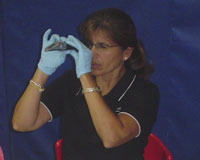NCAA News Archive - 2006
« back to 2006 | Back to NCAA News Archive Index
|
Important landmarks in the history of the NCAA drug-testing program:
1970:
NCAA Council forms the Drug Education Committee.1982: The Drug Education Committee conducts a survey of 1,000 male student-athletes in the Big Ten Conference; 40 percent of respondents say that drug use is a slight or growing problem among varsity athletes.
1982: The University of California, Los Angeles, opens the United States’ first International Olympic Committee-certified drug-testing laboratory.
1982: NCAA staff task force asks the Council to authorize a national drug-use study.
1983: Improved international testing detects anabolic steroid use during the 1983 Pan American Games.
1984: NCAA Convention delegates approve a resolution from the Pacific-10 Conference directing the NCAA Executive Committee to develop a testing program for the Association’s championships.
1985: Executive Committee forms the Special NCAA Committee on Drug Testing, which creates a proposed list of banned medications and a testing protocol.
1986: NCAA drug-testing program adopted at the NCAA Convention. Program begins with 1986 fall championships and bowl games.
1987: A Stanford University diver files a lawsuit, claiming that the drug-testing program violates privacy rights.
1989: Drug-use survey shows a marked increase in anabolic steroid use.
1990: Year-round testing program adopted.
1994: California Supreme Court rules in favor of the NCAA in the privacy-rights lawsuit, saying the Association was "well within its legal rights" in adopting a drug-testing program.
1999: NCAA decides to outsource administration of the program to a private company, The National Center for Drug Free Sport, Inc. (see related story, page A2).
2002: Ephedra included in year-round testing program.
2005: NCAA Committee on Competitive Safeguards and Medical Aspects of Sports receives authority during an appeal of a positive test to reduce the legislated one-year penalty (either by removing the penalty or reducing it to half a season of competition).
2006: Year-round testing program is expanded into the summer months; also, the Division III Presidents Council approves a two-year drug-education and testing pilot program.
© 2010 The National Collegiate Athletic Association
Terms and Conditions | Privacy Policy

